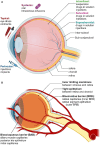Nanoparticle-based optical interfaces for retinal neuromodulation: a review
- PMID: 38572073
- PMCID: PMC10987880
- DOI: 10.3389/fncel.2024.1360870
Nanoparticle-based optical interfaces for retinal neuromodulation: a review
Abstract
Degeneration of photoreceptors in the retina is a leading cause of blindness, but commonly leaves the retinal ganglion cells (RGCs) and/or bipolar cells extant. Consequently, these cells are an attractive target for the invasive electrical implants colloquially known as "bionic eyes." However, after more than two decades of concerted effort, interfaces based on conventional electrical stimulation approaches have delivered limited efficacy, primarily due to the current spread in retinal tissue, which precludes high-acuity vision. The ideal prosthetic solution would be less invasive, provide single-cell resolution and an ability to differentiate between different cell types. Nanoparticle-mediated approaches can address some of these requirements, with particular attention being directed at light-sensitive nanoparticles that can be accessed via the intrinsic optics of the eye. Here we survey the available known nanoparticle-based optical transduction mechanisms that can be exploited for neuromodulation. We review the rapid progress in the field, together with outstanding challenges that must be addressed to translate these techniques to clinical practice. In particular, successful translation will likely require efficient delivery of nanoparticles to stable and precisely defined locations in the retinal tissues. Therefore, we also emphasize the current literature relating to the pharmacokinetics of nanoparticles in the eye. While considerable challenges remain to be overcome, progress to date shows great potential for nanoparticle-based interfaces to revolutionize the field of visual prostheses.
Keywords: nanoparticle transducers; neuromodulation; optical nanosensors; retinal degeneration; retinal pharmacokinetics; retinal prosthesis.
Copyright © 2024 Stoddart, Begeng, Tong, Ibbotson and Kameneva.
Conflict of interest statement
The authors declare that the research was conducted in the absence of any commercial or financial relationships that could be construed as a potential conflict of interest. The author(s) declared that they were an editorial board member of Frontiers, at the time of submission. This had no impact on the peer review process and the final decision.
Figures




Similar articles
-
Activity of Retinal Neurons Can Be Modulated by Tunable Near-Infrared Nanoparticle Sensors.ACS Nano. 2023 Feb 14;17(3):2079-2088. doi: 10.1021/acsnano.2c07663. Epub 2023 Feb 1. ACS Nano. 2023. PMID: 36724043
-
Retinal Prosthetic Approaches to Enhance Visual Perception for Blind Patients.Micromachines (Basel). 2020 May 24;11(5):535. doi: 10.3390/mi11050535. Micromachines (Basel). 2020. PMID: 32456341 Free PMC article. Review.
-
[Aiming for zero blindness].Nippon Ganka Gakkai Zasshi. 2015 Mar;119(3):168-93; discussion 194. Nippon Ganka Gakkai Zasshi. 2015. PMID: 25854109 Review. Japanese.
-
Restoration of vision in blind individuals using bionic devices: a review with a focus on cortical visual prostheses.Brain Res. 2015 Jan 21;1595:51-73. doi: 10.1016/j.brainres.2014.11.020. Epub 2014 Nov 15. Brain Res. 2015. PMID: 25446438 Review.
-
Implantable visual prostheses.Acta Neurochir Suppl. 2007;97(Pt 2):465-72. doi: 10.1007/978-3-211-33081-4_53. Acta Neurochir Suppl. 2007. PMID: 17691336 Review.
Cited by
-
Gold Nanorod-Coated Hydrogel Brush Valves in Macroporous Silicon Membranes for NIR-Driven Localized Chemical Modulation.Gels. 2025 Jan 1;11(1):25. doi: 10.3390/gels11010025. Gels. 2025. PMID: 39851996 Free PMC article.
-
Advancements in Ocular Neuro-Prosthetics: Bridging Neuroscience and Information and Communication Technology for Vision Restoration.Biology (Basel). 2025 Jan 28;14(2):134. doi: 10.3390/biology14020134. Biology (Basel). 2025. PMID: 40001902 Free PMC article. Review.
-
Intravitreally Injected Plasmonic Nanorods Activate Bipolar Cells with Patterned Near-Infrared Laser Projection.ACS Nano. 2025 Apr 1;19(12):11823-11840. doi: 10.1021/acsnano.4c14061. Epub 2025 Mar 20. ACS Nano. 2025. PMID: 40110744
References
Publication types
LinkOut - more resources
Full Text Sources

